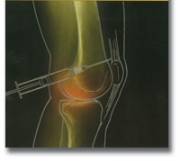Bellevue Morning Report Teaching Points 11/27
 CC: Left knee swelling and pain x 1 week
CC: Left knee swelling and pain x 1 week
54 yo male without past medical history in his usual state of health until 5 weeks prior when he had painful ejaculation and intermittent dysuria, denies penile discharge. Treated for a urinary tract infection with unknown antibiotic. 3 weeks later develops recurrent symptoms and again treated with another course of unknown abx by outside physician. However he develops left knee pain and swelling and is unable to ambulate normally. Is in a monogamous marriage and denies any other sexual contacts. No fevers.
Labs wnl
Synovial Fluid Analysis Left Knee: WBC 2700, no crystals, no organisms on gram stain, cx pending
DDx: Gonococcal Septic Arthritis vs Reactive Arthritis
Teaching Points:
-
All acute, asymmetrically swollen joints need to be tapped immediately to rule out septic joints
-
Septic joint infection can be divided into gonococcal and non-gonococcal arthritis. Common causes of non-gonococcal septic arthritis are staph, strep, and E. Coli.
-
There is rising rate of quinilone resistant GC emerging from SE Asia. Risk factors for this are: sex workers, people with multiple sexual partners, MSM. Mainstay of treatment should be ceftriaxone for GC infections. Given almost 50% co-infection with Chlamydia, patients should also be treated with Doxycycline 100mg x 7 days.
-
It is NOT common to find GC on gram stain or by cultures in acute gonococcal septic arthritis. Furthermore, low white cell counts on synovial fluid analysis can be seen with GC.
-
Reactive arthritis usually occur 2-4 weeks after preceeding infection either by #1 GI bugs (salmonella, yersinia, campylobacter) or #2 GU infection (GC, Chlamydia). Mainstay of tx is NSAID.

2 comments on “Fast Facts-Rheumatology”
What was the final diagnosis?
GC is usually poly- or pauci-articular, affecting the knee most commonly, and then the elbow and ankle. It is generally a disease of younger patients, although certainly would be in the differential in this case. Two thirds of patients have an associated dermatitis, and 25% may present with coinciding genitourinary symptoms. Gram stain of the synovial fluid is positive in only 25% of cases.
One addditional comment: if GC is diagnosed, the patient should receive empiric antibiotic coverage for Chlamydia as well, since these microbes often travel together.
Clinically, the patient responded very quickly to antibiotic treatment. On admission he received ceftriaxone for GC coverage and doxycline in case their was co-infection with Chlamydia. By HD#1 his knee pain/stiffness greatly improved and his effusion essentially resolved.
The GC probe of the urethra was negative, which is not uncommon in GC septic arthritis. To date the cultures from the arthrocentesis have not grown bacteria, which too is not uncommon.
He did not receive NSAIDs for his arthritis, which is the treatment for a reactive arthritis.
Given his clinical improvement with antibiotics, we believe that he probably had gonococcal septic arthritis.
Comments are closed.